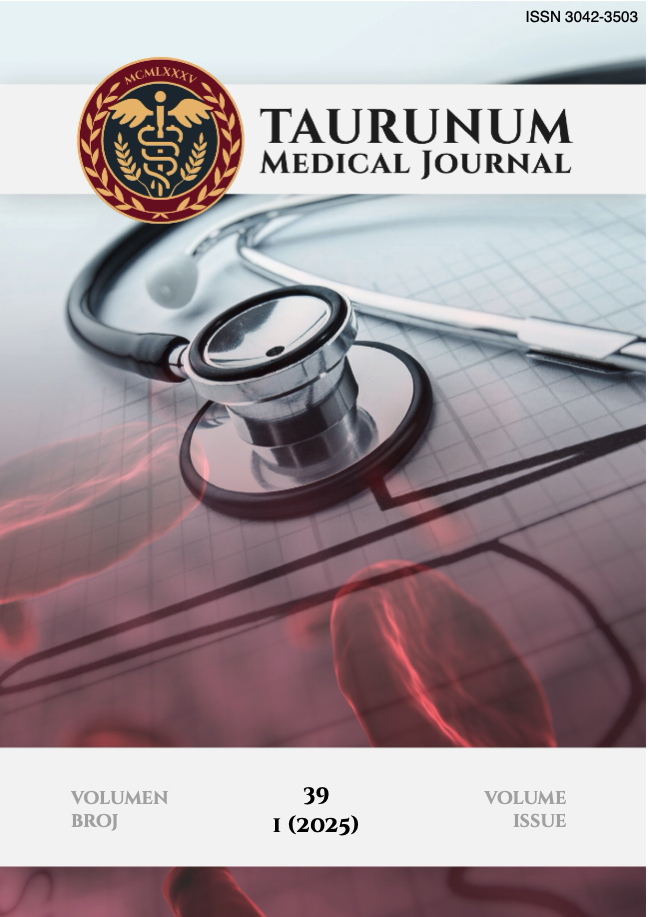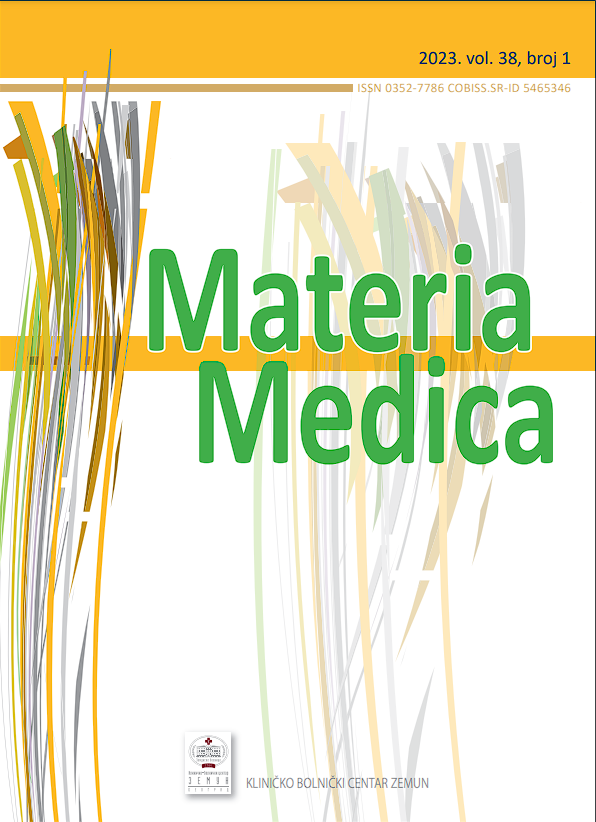Current issue

Volume 39, Issue 1, 2025
Online ISSN: 3042-3511
ISSN: 3042-3503
Volume 39 , Issue 1, (2025)
Published: 31.03.2025.
Open Access
Welcome to Issue 39, No. 1 – the first of our two annual publications for this year. Inside, you'll find a curated selection of articles. Start your year with the essential knowledge and perspectives offered in this timely edition
All issues
Contents
01.04.2018.
Poster session
Metastasis of lymph nodes melanoma with chronic lymphocytic leukemia/ small lymphocytic lymphoma: case report
Aim: Purpose of this report is to present metastasis of lymph nodes melanoma with chronic lymphocytic leukemia/small lymphocytic lymphoma (CLL/SLL) as an example of collision tumor of an uncommon synchronic occurrence in the lymph node. Introduction: Synchronic, composite tumors are rare and their simultaneous and synchronic occurence within the same tissue/organ is even more rare. CLL/SLL is an indolent, clonal disease of mature B-lymphocytes which occurs mostly with adults. After the treatment with chemotherapeutic agents the occurence of the secondary malignancies (melanoma,squamous-cell carcinoma). Material and Methods: We present a 77 year old male who, after right sided nephrectomy caused by clear-cell carcinoma was diagnosed with CLL/SLL with bone marrow and lymph node infiltration. After three years and chemotherapy, skin changes were excised which histomorphologically resembles melanoma. After the immunotherapy for melanoma, the enlarged lymph nodes were extripated from the neck and histomorphologically and immunohistochemically treated. Results: Histomorphologically, a diffused infiltration of small B-lymphocytes was found in the lymph node, with round nuclei, condensed chromatin, inconspicuous nucleoli, scant cytoplasm unique immunophenotype: CD20 ,PAX-5 ,CD5 ,CD23 ,Cyclin D1-,CD3-. A part of lymph node was infiltrated by epitheloid cells with immunohistochemic profile: S-100 ,Melan A ,HMB-45 . Histomorphological and immunohistochemical CLL/SLL with melanoma infiltration as an example of a collision tumor was proved. Conclusion: Lymphoproliferative neoplasms including CLL/SLL represent an risk of synchronous, metachronous development of secondary malignancies including melanoma itself and they can uncommonly present themselves as synchronic collision tumors within the same organ.
Dragan Zivojinovic, Olga Radic-Tasic, Sasa Ristic, Olivera Tarabar, Zoran Mirkovic, Milica Rajovic
01.04.2018.
Poster session
Extrapleural solitary fibrous tumor of the neck: A Case Report
Aim: Immunohistochemistry findings along with clinical features, are significantly important in differentiating the Extrapleural SFT in the neck, from other well-circumscribed mesenchymal neoplasms at this locations. Introduction: We present a rare case of a Extrapleural SFT in a 57 years old man in the neck, without significant past medical history. Material and Methods: The patient had a painless slow growing tumor, in right sight of the neck, diagnosed with physical examination. Total excision with local anesthesia was done, without previously biopsy of the tumor and other clinical investigations. Standard procedures for histology and immunohistochemical stains were done. Results: Tumor was well circumscribed, encapsulated measuring 5,5x4x4 cm. On section, the cut surface had a multinodular, whitish and firm appearance. On microscopic examination tumor was composed of alternating hypocellular and hypercellular areas separated from each other by thick bands of collagen and branching haemangiopericitoma like vessels. The tumor cells were round to spindle-shaped with little cytoplasm, indistinct borders, dispersed chromatin within vesicular nuclei. Area of myxoid change and subcapsular focus of hemorrhage was present, and 2 mitoses/10 HPF were found. Immunohistochemistry revealed diffuse positivity for CD34, Vimentin and BCL2, focal positivity for CD99, S100, SMA, and negativity for CKWS and EMA. Ki67 showed low proliferating index 3-5%. Conclusion: Although most cases of SFT are benign, there is no strict correlation between morphology and behavior, so patients with extrapleural solitary fibrous tumor have need of long-term post-resection follow-up. Further studies are needed to determine the optimal management of these neoplasms.
Blagjica Lazarova, Slobodan Rogach, Gjorgi Velkov, Elena Aleksoska, Gordana Petrusevska, Liljana Spasevska
01.04.2018.
Poster session
Splenic myoid angioendothelioma
Aim: To present three cases and review literature of splenic myoid angioendothelioma (SMA) focusing on immunohistochemical features. Introduction: SMAs are very rare, mainly in middle-aged and elderly patients of both sexes and are characterized by a mixed proliferation of cord capillaries and myoid cells, distinguished from other splenic angioendotheliomas by additional myogenic/myofibroblast differentiation. Material and Methods: Three cases of SMA from the Department of Histopathology Registry of Clinical Centre of Serbia were detected during last 12 years (2006-2017) in one male and two female patients (42,5 ys average age). Histomorphological findings were revised by reviewing all serial HE sections, histochemical trichrome stains and immunohistochemical stainings for CD8, CD31, CD34, CD68, SMA, desmin and Ki-67. Results: All cases showed sharply demarcated non-encapsulated solitary tumors with diameters 42, 55 and 20 mm. Histologically there are dense network of capillary blood vessels intermingled with polygonal myoid stromal cells and at least focally expressed non-homogeneous cellularity of stromal and lymphoid cells with focal sclerosis. Neocapillaries show distinctive CD8- / CD31 / CD34 immunophenotype (differing them from splenic hamartomas) and characteristic mixture with myogenic elements (differing them from cord capillary hemangiomas): intense SMA (3/3), rare focal desmin (2/3) and focal CD68 (1/3) immunoexpression. Conclusion: SMA is underrecognized type of vascular neoplasia, which has a clinico-pathological differential diagnostic significance because it radiologically imitates splenic metastase. Cellular form of SMA must be distinguished from hamartoma, but also from hemangiopericytoma and well-differentiated angiosarcoma of the spleen
Milena Ćosić Micev, Marjan Micev, Marko Andrejević, Maja Dimić Čumić, Aleksandra Dikić Rom, Slavko Matić, Nikica Grubor
01.04.2018.
Poster session
Cardiac sarcoidosis: Case report
Aim: We present the case of a patient aged 68 years who died of chronic heart failure caused by untreated cardiac sarcoidosis (CS). Introduction: Sarcoidosis is a multisystem disorder of unknown etiology, characterized by granulomatous infiltration and the development of noncaseating granulomas in many organ systems. Although the lungs, eyes, and skin are most commonly affected, virtually any body organ can be involved. Clinical evidence of CS is seen only in 5% of patients and the disease may present with tachyarrhythmias, conduction disturbance, heart failure, or sudden cardiac death. Case report: The patient was received in the hospital due to symptoms and signs of global cardiac decompensation with difficulties in the form of dyspnea, orthopnea, and edematous legs. Echocardiographic, cardiac cavities are very dilated with globally reduced systolic function, severe mitral regurgitation and ejection fraction about 20%. Very soon after receiving the patient is died. At autopsy, the heart was dilated, primarily the left ventricle. Histologically, the myocardium was infiltrated by numerous granulomas built of lymphocytes, epitheloid cells, and giant multicellular cells of the Langhans type. As a consequence of severe chronic heart failure, the lungs were edematous with both sides of massive plural effusions. The coronary arteries were non-significantly stenosed. Conclusion: Early diagnosis and treatment can prevent significant morbidity and mortality in patients with CS. It is very important that patients with CS in the early stage of the disease be treated with corticosteroids.
Golub Samardzija, Snežana Tadic, Marija Bjelobrk, Dragana Tegeltija, Aleksandra Lovrenski, Bojana Visnjic Andrejic
01.04.2018.
Poster session
Clinical and morphological characteristics of the cardiac tumors
Aim: To analyze age and sex distribution of the cardiac tumors, the most common clinical symptoms, POSTER SESIJA 70 MATERIA MEDICA • Vol. 34 • Issue 1, suplement 1 • april 2018. pathohistological types, tumor localization and compare the echocardiographic with the pathohistological size of the tumor. Introduction: The incidence of primary cardiac tumors are very rare and amounts to about 0.02%. Incidence of secondary cardiac tumors are significantly higher. Primary malignant cardiac tumors are very rare and represent to the rarest tumors in the human organism. Materials and Methods: The study covered 49 patients who were operated in the period from 2008 to 2017. Patients data are obtained from the history of the disease, the information system and pathohistological findings. Results: The average age of the patients is 53.9 years. The most common symptoms were light fatigue, heart palpitations, vertigo, dizziness, dyspnea, exhaustion, cough and stenocardia. The most commonly diagnosed are myxomas (67.3%), papillary fibroelastomas 28.6%, cavernous hemangiomas 4.1%, and metastatic tumors 2.04%. The most common tumor localization is in the left atrium 63.3%, aortic cusps 16.3%, right atrium 8.2%, mitral valve 8.2%, left ventricle 2.04% and interventricular septum 2.04%. The difference in mean echocardiographic tumor size and tumor size after surgical extirpation was not statistically significant (p = 0.706). Conclusion: Although, cardiac tumors are rare, they have a large clinical importance, primarily because of the potential for severe complications such as embolization of the arteries of the brain with the development of cerebral infarction and even the appearance of sudden death. However, timely diagnosis and surgical removal of tumors lead to patient curing in most cases.
Golub Samardzija, Iva Bosic, Lazar Velicki, Milenko Rosic, Dragana Tegeltija, Aleksandra Lovrenski, Bojana Visnjic Andrejic
01.04.2018.
Poster session
Metastasis of gastric signet ring cell carcinoma to the ureter
Aim: We present an interesting case of unexpected metastatic deposit “signet ring cell” of the gastric cancer in the ureter. Introduction: Ureteral obstruction caused by gastric cancer may occur by any of the following three mechanisms: direct extension from the primary site, peritoneal deposit or lymph node metastasis. Material and Methods: We report the case of a patient with ureteral metastasis as the first and sole manifestation of gastric cancer dissemination two years after he was first diagnosed with gastric cancer. Results: A 52-year old male patient was admitted to the Department of Urology, Clinical Hospital Centre Zvezdara in Belgrade, with a 5-day history of right colic flank pain and high temperature. He had a partial gastrectomy for gastric cancer two years ago and received 8 cycles of chemotherapy. Routine blood test results were normal except elevated creatinine and C-reactive protein levels. An abdominal ultrasound examination and computed tomography revealed grade 3 hydronephrosis and hydroureter. Cystoscopy indicated a tumor measuring 2 cm in size which involved left ureteral orifice. A left nephroureterectomy and transurethral resection of bladder tumor were performed. Histopathological examination of surgical POSTER SESIJA 65 MATERIA MEDICA • Vol. 34 • Issue 1, suplement 1 • april 2018. specimen revealed signet ring cell carcinoma infiltrating lamina propria and tunica muscularis of the left lower ureter. Histopathological examination of the bladder specimen revealed signet ring cell carcinoma identical to those of the ureteral tumor. Conclusion: Ureteral metastases from gastric cancer are extremely rare. Shimoyama reviewed 27 cases of the true ureteral metastasis from gastric cancer. The prognosis is generally poor and the survival for more than 2 years has not been reported in literature.
Marija Milic Perovic, Aleksandra Paunovic Markovic, Nata a Djurdjevic, Marija Cubrilo, Jelena Kuzmanovic, Jovan Juloski, Lidija Vuckovic Hardi
01.04.2018.
Poster session
A rare localization of alveolar soft part sarcoma: a case report
Aim: We present the case of a rare localization of the alveolar soft part of the sarcoma in the visceral organ. Introduction: Alveolar soft part sarcoma (ASPS) is a rare mesenchymal tumor typically occurring in young patients, more frequently in females. Common localization of ASPS is skeletal musculature of lower extremities. ASPS in visceral organs usually represents a metastasis from the more common primary location in skeletal muscles. ASPS is characterized by a tumor-specific translocation which causes the fusion of the TEF3 with a ASPL gene (also known as ASPSCR1). Case report: Female 47 years old was admitted to hospital due to abdominal pain. Urgent surgery was performed due to ileus. Ileal tumor was detected intraoperatively as a cause of ileus. Tumor was infiltrated whole intestinal circumference, with dimension 70mm x 47cm and evident perforation. Histology showed well-defined nests of pleomorphic cells separated by delicate fibrovascular septae. Within described nests there is a prominent lack of cellular cohesion, representing for the distinctive pseudoalveolar pattern. Immunohistochemical stadies were diffusely positive for TFE3 and focally positive for CD34 and alpha-SMA and negative for panCK, DOG-1, CD117, S-100, HMB45, Desmin. Immunopositivity for Ki67 was present in 20% of tumor cells. FISH analysis was done using locus specific dual color break-apart TFE3 (3 and 5 ) probe and rearrangement in the TFE3 gene was confirmed. Conclusion: Despite the fact that ASPS is rare mesenchymal tumor in visceral organs it have to be considered as possible diagnosis especially in cases with typical histological features and immunohistochemical profile. Definitive diagnosis of ASPS must be confirmed by FISH analysis.
Radmila Jankovic, Jelena Sopta, Sanja Cirovic, Martina Bosic, Jovan Jevtic, Ljubica Simic
01.04.2018.
Poster session
Melanoma malignum chorioideae: case report
Aim: The present a rare case intraocular primary malignant choroidal melanoma. Introduction: Melanoma choroideae is most common intraocular primary tumor of adults. Incidence is 7 cases per 1 million people per year and incidence of this tumor increases with age. Case report: We report 76 years old women who had progressive visual field defects at left eye at least two years. Diagnostic examination of eye was detected a greyish-brown mass of the posterior choroidal pole which was indication for enucleation. Macroscopically bulbus oculi was dimension 28x25x25mm, with optic nerve 5mm length. At the intersection on posterior pole nearby papila of optical nerve was detected ovoid dark lesion diameters 8x3mm. Histopathology examination was showed sharply demarcated solid tumor islands which consists of epithelioid tumor cells with pleomorphic, atypical nuclei, conspicuous nucleoli. Other type of cells were spindle look which formed fascicular shapes. Pigmentation was absent also. There was no significant vascularisation in tumor mass. Sclera was superficially infiltrated by tumor cells. Mitotic activity was absent (0/40HPHF). Immunohistochemistry staining was confirmed melanoma cells: S-100, MelanA , HMB-45 /-. Conclusion: Melanoma in this region is rare, indolent lesion, with bad prognosis. Early detection could prevent further dissemination of disease and many complications. Metastatic choroid melanoma is a highly malignant disease with a limited life expectancy.
Darko Mikic, Snezana Cerovic
01.04.2018.
Poster session
Activity of the Parathyroid Glands in Patients with Hyperparathyroidism: An immunohistochemical analysis
Aim: Determining the immunohistochemical characteristic of parathyroid glands (PG) proliferative activity in patients with primary and secondary hyperparathyroidism (HPT) using cell cycle and proliferation immunohistochemical markers, Ki -67 and PCNA. Introduction: A few studies results have shown A few studies results have shown significant detection of Ki-67 in hyperplasia due to secondary hyperparathyroidism (sHPT), whereas it s demonstrated only in adenomas in primary HPT (pHPT). The highest PCNA expression is detected in hyperplastic PG in sHPT and in adenoma in pHTP, but in pHTP hyperplasia it s extremely low. Material and Methods: We analyzed the surgically removed PG of 96 patients with HPT. In POSTER SESIJA 64 MATERIA MEDICA • Vol. 34 • Issue 1, suplement 1 • april 2018. addition to standard histopathological parameters the results of immunohistochemical reaction of Ki-67 and PCNA in 23 normal, 73 hyperplastic PG and 23 adenoma were analyzed. Results: 41 (42.7%) patients had pHPT, and 55 (57.3%) sHPT. Within pHPT adenoma was diagnosed in 23 (56.1%) patients and hyperplasia in 18 (43.9%). Detection of PCNA was 94.4% in pHPT hyperplasia, 91% in sHPT hyperplasia, and 83% in adenoma. 22 (98%) of the normal PG didn t have PCNA expression. The expression of Ki-67 was found in 13 (56.5%) adenomas and in 11 (18.3%) nodular hyperplasia. The high statistical significance for Ki-67 (p <0.0001) was found between adenoma and pHPT and sHPT. Conclusion: The results of our analysis showed high Ki-67 and PCNA expression in parathyroid adenomas. Increased Ki-67 expression corresponds with increased cellular proliferation and contributes to tumorigenesis in many organs, but doesn t distinguish accurately benign from malignant PG tumors.
Snezana Cerovic, Bozidar Kovacevic, Sanja Dugonjic, Milena Jovic, Jelena Dzambas
01.04.2018.
Poster session
Metastasis in the upper urinary tract as initial presentation of invasive lobular breast cancer
Aim: Reporting a patient with unusual metastatic site of invasive lobular breast cancer (ILC) as initial presentation of the disease. Introduction: Due to specific growth pattern, ILC rarely forms an apparent tumor, which makes diagnosis very challenging at early stage. ILC is also known for unconventional metastatic spread, with deposits being discovered prior to the primary tumor in 3-10% of cases. Case report: While evaluating renal function in 51-year old female patient hospitalised at the Urology Clinic (Clinical centre of Montenegro), static scintigraphy revealed left kidney functional capacity of 7-8%. Nephrectomy was indicated. Kidney, 11x6x4cm in size, with slightly reduced, paler parenchyma, firmly attached fatty capsule and pyelocaliceal system and ureter of regular gross appearence, was delivered to the Centre for Pathology. Analysis of H E sections revealed chronic pyelonephritis. In a few sections taken from urether, pyelon and subcapsular parts of parenchyma, infiltrates of small, cuboid, atipical cells, mostly arranged in one-cell-thick files, were noted. Immunohistochemistry reveiled strong pozitivity for EMA, CK(ae1/ae3), CK7, estrogen and mammaglobin, with Ki67<10%. A few cells were progesteron positive, while vimentin, CK20 and neuroendocrine markers were negative. ILC metastasis was suspected. ILC, with axillary lymph POSTER SESIJA 66 MATERIA MEDICA • Vol. 34 • Issue 1, suplement 1 • april 2018. node involvement, was confirmed later, although there was no macroscopically apparent tumor in the breast. Tumor cells were estrogen and progesterone positive, HER2 negative, with Ki67 of 3%. Conclusion: While assessing metastatic deposits in unconventional sites in women, primary ILC should be considered. Special diagnostic algorhytm is required for efficient initial detection of the primary tumor.
Jelena Vucinic, Janja Raonic, Ljiljana Vuckovic, Filip Vukmirovic, Mileta Golubovic, Tanja Nenezic, Petar Kavaric









